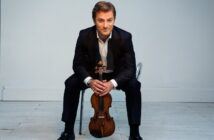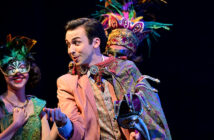by Paul E. Robinson
While opera fans are notoriously old-fashioned when it comes to stage directors bringing overarching new ideas to their favourite works, it is clear that if opera is going to have any future, it must be open to creative re-thinking.
Wieland Wagner successfully updated his grandfather’s Ring cycle at Bayreuth in the 1950s, and Karajan and Schneider-Siemssen used cutting edge projection technology to add a new dimension to the Ring cycle at Salzburg in the 1960s. In 1976, Patrice Chereau gave us something to think about with his radical new Ring at Bayreuth. In 2011, we have Robert LePage plumbing the depths of his prodigious imagination to produce an early 21st century Ring at the Met.
Watching LePage’s Die Walküre, live in HD from the Met, I was often enraptured by the words and the music and moved to tears on several occasions. It was a magnificent production – no doubt about it – with some of the finest Wagnerian singing and conducting one could ever hope to hear. LePage, the stage director, deserves much credit for the power of the experience.
That said, LePage’s overall vision can only be described as “underwhelming” at best and, under the circumstances, obscenely expensive.
The Machine With a Mind of its Own!
Peter Gelb must have lost his mind the day he agreed to fund a new Ring cycle based on a 45-ton machine (photo:above) that required the Met to reinforce its own stage. “The Machine”, as it is called at the Met, is a giant seesaw with 24 aluminum planks. It can be manipulated to make all manner of architectural and/or symbolic configurations. Standing more or less vertical, it acts as a screen for projections.
In theory, this set piece was promising; in practice, it proved hard to handle. On the opening night of Das Rheingold, the ‘rainbow bridge’ conversion failed to materialize and the gods were left to make a mortal exit – stage right.
Such difficulties persisted. The “Met Live in HD” performance of Die Walküre I attended started 35 minutes late while technicians scrambled to figure out why their computers were not able to communicate with the encoding sensors in the planks.
Inhibitor Rather than Facilitator of Directorial Creativity?
Worse than these technical difficulties, in my opinion, was the realization that director Lepage’s (photo: right) “Machine” gave us little of artistic merit to justify the enormous amounts of time and money spent on it, and led, it seemed, to some rather inappropriate directorial choices; for example, did we really need “The Machine” to show us Valkyries pretending to ride horses (photo:above) – some said it looked more like surfing – in Act III? Or the planks jacked up vertically to form a wall – as they were for Siegmund and Hunding’s battle – thereby reducing the vast Met stage to a long, narrow downstage playing area, giving this critical scene a cheap and claustrophobic look, when it should have been apocalyptic! Or Brünnhilde, in the final scene of the opera, lying, not on a rock but upside down at the top of a wall. What was that about?
In this scene, Wotan – with Loge’s invisible help – lit the “magic fire” that surrounds and protects Brünnhilde. Projections on “The Machine” showed what passed for “fire” in this production. But surely Wagner intended something awe-inspiring here – a fire massive and threatening enough to fend off all comers with the exception of the hero (Siegfried) who alone will be capable of braving the conflagration to wake Brünnhilde.
LePage’s fire was puny and wouldn’t have frightened a child.
During the scene in Hunding’s hut, while Siegmund is telling Sieglinde his life’s story, the audience viewed projections on “The Machine” of moving figures in black suggesting warriors and dogs in combat. It was all rather primitive and unnecessary; one easily got the sense of the story from the words and the music.
In short, “The Machine” is not nearly as versatile as its inventor imagined it would be. My overall impression is that LePage simply ran out of creative ways to use it.
Stars Upstage “The Machine” in Movie House
Fortunately, at least in the HD version, audiences could spend less time being disappointed in the set and more being fascinated by the characters in close-up. The Metropolitan Opera House is a huge barn of a place with most customers seated too far away to see facial expressions without opera glasses. The “Met Live in HD” changes this relationship and the technology pays enormous dividends.
Wagner’s Ring has its big moments, but more often it is a sort of recitative with characters telling stories in intricate verse. In this particular production, the words really meant something and were sung with deeply convincing expression. And we, the “Met Live in HD” audience, had the added benefit of ‘seeing’ the physical expression of that emotion. Most expressive, perhaps, was Bryn Terfel (photo:right). Even with only one eye, he communicated volumes, and made every syllable count. His vocalizing was glorious, especially in the final scene, as he sings goodbye to his beloved Brünnhilde.
Most expressive, perhaps, was Bryn Terfel (photo:right). Even with only one eye, he communicated volumes, and made every syllable count. His vocalizing was glorious, especially in the final scene, as he sings goodbye to his beloved Brünnhilde.
Deborah Voigt (photo:right) was an ideal Brünnhilde. She looked young enough to be Wotan’s daughter – a rare occurrence in Ring cycles – had plenty of voice for this demanding role and presumably with LePage’s encouragement, brought out the strength, the vulnerability and the playfulness of this character. As Siegmund (photo:right), Jonas Kaufmann was uncommonly handsome and his singing got better as the performance unfolded. He tended to go sharp in his upper register in Act I but was pretty much dead-on in Act II. He doesn’t have the stentorian tones of a classic Heldentenor, but at his best he projects both strength and beauty of sound. As his sister Sieglinde, Eva-Maria Westbroek (photo:right) also sang with strength and beauty and produced a special richness in the lower register. When these two lovers kissed, we believed it was the real thing.
As Siegmund (photo:right), Jonas Kaufmann was uncommonly handsome and his singing got better as the performance unfolded. He tended to go sharp in his upper register in Act I but was pretty much dead-on in Act II. He doesn’t have the stentorian tones of a classic Heldentenor, but at his best he projects both strength and beauty of sound. As his sister Sieglinde, Eva-Maria Westbroek (photo:right) also sang with strength and beauty and produced a special richness in the lower register. When these two lovers kissed, we believed it was the real thing.
It is no longer news that Stephanie Blythe is one of the Met’s greatest assets. In the role of Fricka in this production, she matched Terfel in both inspired histrionics and subtlety of phrasing. Making her entrance on top of ‘The Machine” in what appeared to be a mechanized wheelchair – albeit without wheels – she never left it. Was this device meant to suggest she was disabled? Was it a throne? Or was it was just another way to justify “The Machine”.
Maestro James Levine on the Podium Despite Health Issues The extraordinary performances in this Ring could only be fully realized with the support of a fine orchestra and an authoritative conductor. We had both in this performance. The Met Orchestra, a virtuoso ensemble, played with heart-rending expressiveness from beginning to end. The intermission feature with players from the brass section introducing their instruments – especially the Wagner tubas – demonstrating their sounds, and explaining what the ‘leitmotifs’ do, was excellent.
The extraordinary performances in this Ring could only be fully realized with the support of a fine orchestra and an authoritative conductor. We had both in this performance. The Met Orchestra, a virtuoso ensemble, played with heart-rending expressiveness from beginning to end. The intermission feature with players from the brass section introducing their instruments – especially the Wagner tubas – demonstrating their sounds, and explaining what the ‘leitmotifs’ do, was excellent.
This performance also had the air of an historic occasion, thanks to James Levine’s presence on the podium. Levine (photo:right) has suffered mightily in the past few years as his health has deteriorated. His pain and physical incapacity have gotten so bad that he has had to give up the music directorship of the Boston Symphony and to cancel dozens of performances at the Met. There was a great deal of uncertainty as to whether he would be able to conduct this performance of Die Walküre. Happily, he not only showed up, but was in total control of the performance from the opening bars. At the end of the opera, he remained seated at the podium in the pit instead of joining the cast on stage for bows; but even the healthiest of conductors have been known to exhaust themselves conducting operas as long and as complex as Die Walküre.
The music was in excellent hands but what appeared on stage was less satisfactory. For all the hype about LePage’s remarkable new equipment, invented to give us an imaginative re-telling of the Ring, we waited in vain for ‘The Machine” to burst forth with a genuine ‘coup de theâtre’ Even more significant, perhaps, was its failure to serve the arch of the drama.
By all means, let’s have a unit set that morphs from one scene to another, but as it morphs let it complement the storyline – let it, in the case of the Ring, enable us to visualize the worlds of both gods and men, and let it illuminate the arenas in which they intersect as each is affected by uncontrolled pride, greed and passion.
LePage’s machine may have been conceived as a ‘means to an end,’ but halfway through this Ring cycle, it has become a deeply flawed end in itself.
Paul E. Robinson is the author of Herbert von Karajan: the Maestro as Superstar, and Sir Georg Solti: His Life and Music. NEW for friends: The Art of the Conductor podcast, “Classical Airs.”
“Die Walküre” Battles “The Machine”
0
Share:














